FRIDAY, AUGUST 12
■ The Perseid meteor shower should be at its peak late tonight, but the light of the Moon, just a day past full, will compromise the view this year. Only the brightest of the meteors will shine through. The shower always appears most active from 11 or midnight until dawn local time, when your side of Earth faces most directly into the oncoming meteors (i.e., the shower's radiant is highest).
Layer up warmly even if the day was hot; remember about radiational cooling under a clear, open sky. A sleeping bag or heavy wrap-around blanket makes good mosquito armor, and use DEET on the parts of you that remain exposed. Lie back in a reclining lawn chair facing away from the Moon. Be patient.
The shower's radiant, in northern Perseus under Cassiopeia, would be the meteors' perspective point of origin if you could see them coming from far away in space. But the meteors only become visible in their last moments when they hit the upper atmosphere, and this can happen anywhere in your sky.
See Bob King's Perseids are Coming, Full Moon or Not.
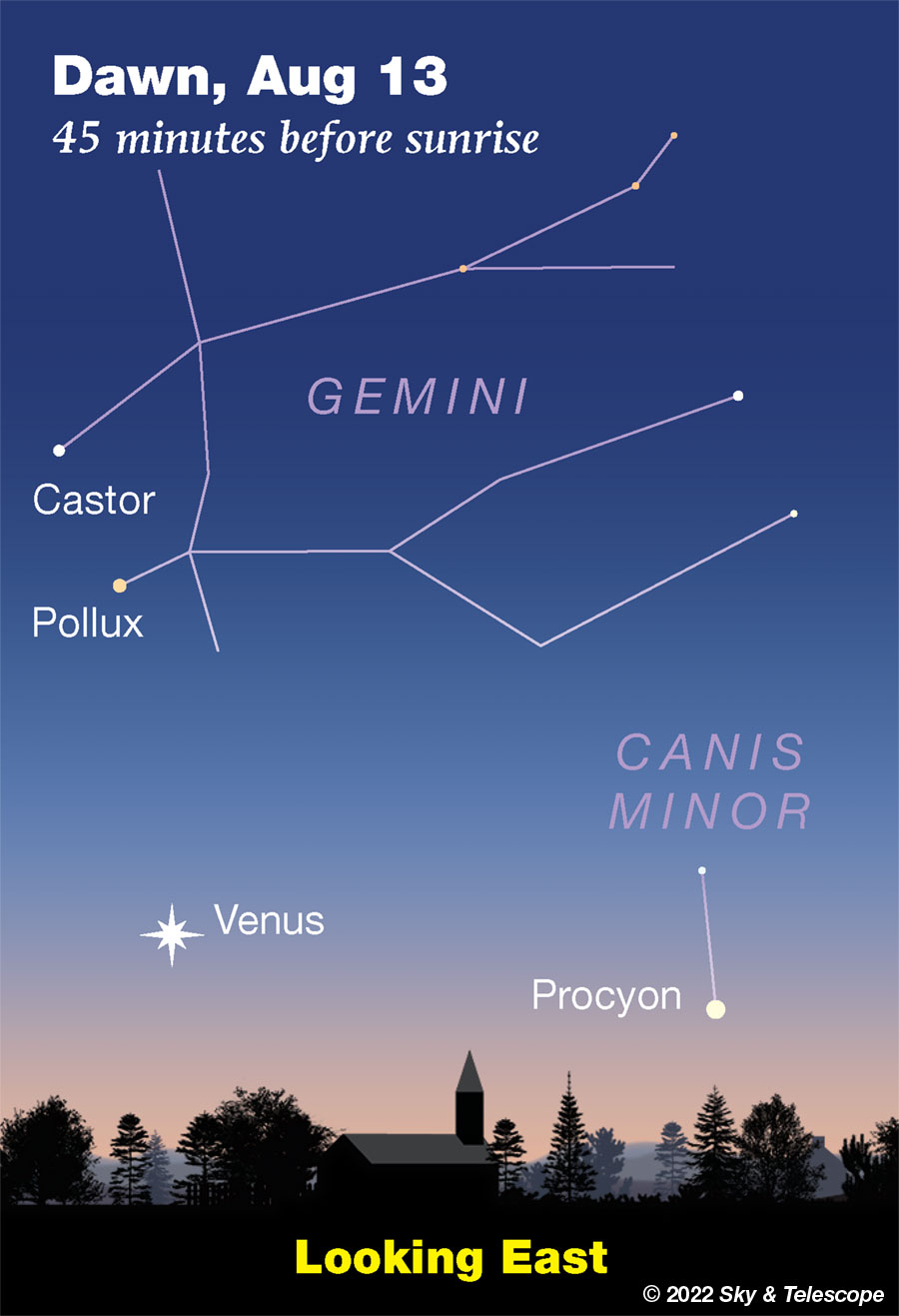
SATURDAY, AUGUST 13
■ Saturn is at opposition tonight, directly opposite the Sun in our sky. So it's highest around the middle of the night.
In a telescope, do you notice that Saturn's rings seem a little brighter than usual compared to Saturn's globe? This Seeliger effect is caused by the solid ring particles backscattering sunlight to us when the Sun is almost directly behind us (i.e. Saturn at opposition). The dusty surfaces of the Moon and Mars also display this "opposition surge," but Saturn's cloudtops do not. In the case of Saturn the effect is named for Hugo von Seeliger, who studied it in detail and published his findings in 1887.
Watch it diminish and disappear in the next several nights.
SUNDAY, AUGUST 14
■ The waning gibbous Moon rises due east soon after dark, with Jupiter shining 5° to its left (for North America). By midnight they're at least 20° up in the east-southeast. By dawn on Monday the 15th they've moved over high toward the southwest, with Jupiter now over the Moon as shown below.
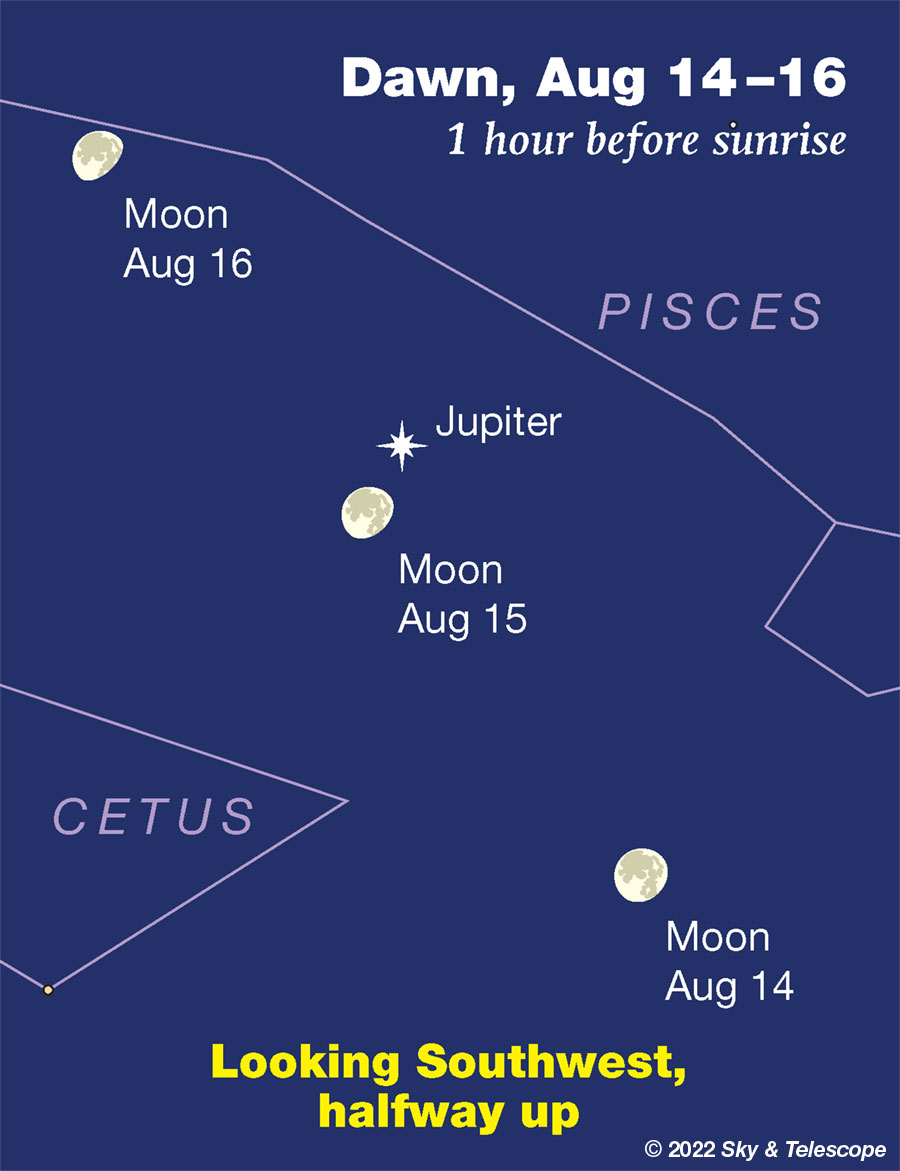
MONDAY, AUGUST 15
■ Double shadow transit on Jupiter. Telescope users in much of North America tonight get a good chance to see two of Jupiter's moons casting their tiny black shadows onto the planet at once.
The flyspeck shadows of Io and Ganymede will enter the eastern edge of Jupiter's bright disk at 11:34 and 11:59 p.m. Eastern Daylight Time, respectively. Both shadows will remain on Jupiter's disk until Io exits from the western limb at 1:38 a.m. EDT.
Easterners get the best view, with Jupiter high where poor seeing is less likely to blur the shadows out of view. Jupiter will be lower in the Central and especially Mountain time zones. Far westerners have only a very iffy shot at the last 20 minutes or so of the event, with Jupiter still low in the east.
TUESDAY, AUGUST 16
■ As summer progresses and Arcturus moves down the western sky, the kite figure of Bootes sprouts from Arcturus toward the upper right. The kite is 23° long, about two fists at arm's length. It's rather narrow, and its top is bent to the right. Arcturus is its bottom point where the stubby tail is tied on. The tail currently flutters downward.
The Big Dipper slants at about the same height in the northwest, to the Kite's right.
WEDNESDAY, AUGUST 17
■ As August proceeds and nights begin to turn chilly, the Great Square of Pegasus looms up in the east, balancing on one corner. Its stars are only 2nd and 3rd magnitude, and your fist at arm's length fits inside it.
From the Square's left corner extends the main line of the constellation Andromeda: three stars (including the corner) about as bright as those forming the Square.
This whole giant pattern was named "the Andromegasus Dipper" by the late Sky & Telescope columnist George Lovi. It's shaped sort of like a giant Little Dipper with an extra-big bowl. It's currently lifting its contents upward.
The actual Little Dipper, meanwhile, is tipping over leftward in the north. It's only 40 percent as long as the Andromegasus Dipper, and most of it is much fainter. As always, you'll find that it's oriented more than 90° counterclockwise compared to Andromegasus. It's currently dumping its contents out.
THURSDAY, AUGUST 18
■ Last-quarter Moon (exact at 12:36 a.m. tonight EDT). The half Moon comes up around 11 or midnight tonight, with bright orange Mars only about 2° under it for skywatchers in North America. About 4° upper left of the Moon, spot the Pleiades.
FRIDAY, AUGUST 19
■ For months, most of the naked-eye planets have been hanging out in the early morning sky. Now Saturn becomes the first of the crew to return to evening view as early as late twilight. See below. It shines higher through the rest of the night.
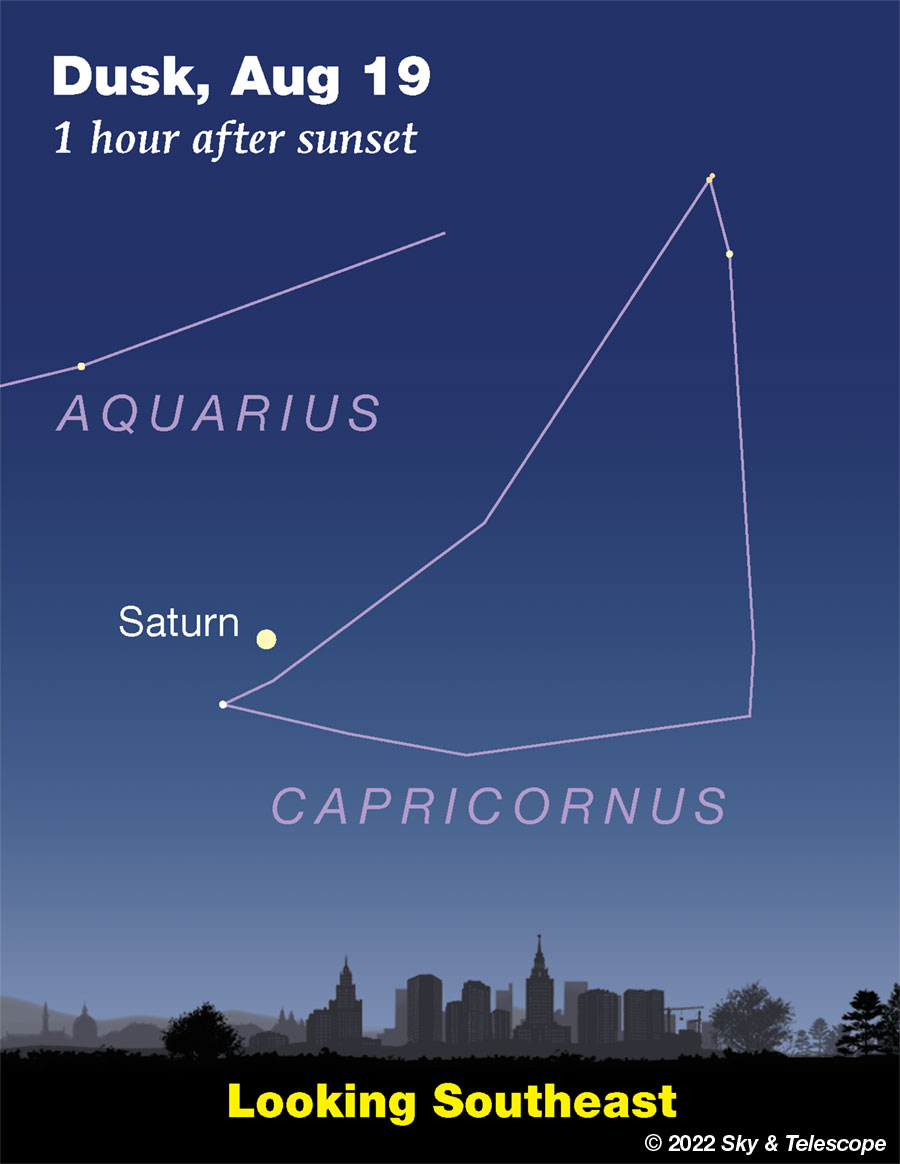
Nearly 20° to Saturn's upper right after full dark are the other two brightest stars of Capricornus, Alpha and Beta Cap. Alpha, the one on top, is an easy binocular double star. Beta is also a binocular double but less easy; its secondary star is both closer and fainter. Beta's secondary is in roughly the same position angle (orientation with respect to the primary) as Alpha's.
SATURDAY, AUGUST 20
■ August is prime Milky Way time, at least when the Moon is out of the evening sky as it is now. After dark the Milky Way runs from Sagittarius in the south, up and left across Aquila and through the big Summer Triangle very high in the east, and on down through Cassiopeia to Perseus rising low in the north-northeast.
This Week's Planet Roundup
Mercury is very low in the sunset glow. About 20 or 30 minutes after sunset, try scanning for it with binoculars just above the horizon due west. Good luck. At least Mercury is fairly bright: about magnitude 0.0 all week.
Venus, magnitude –3.9 in Gemini, rises just after dawn begins. As dawn brightens, look for it low in the east-northeast. It's far below Capella.
Mars, magnitude +0.1 in Taurus, rises around midnight exactly east-northeast. By early dawn it shines very high in the southeast. It's twice as bright as similarly colored Aldebaran, which is a fist or so below or lower left of it by dawn.
Mars is still pretty small in a telescope, 9 arcseconds in apparent diameter, but it's growing. It'll be 17 arcseconds wide around opposition December 8th.
Jupiter rises due east soon after the end of twilight, shining at a bright magnitude –2.8 at the Pisces-Cetus border. It's highest in the south in the hours before dawn. In a telescope Jupiter is 47 arcseconds wide, nearly its maximum. Jupiter comes to opposition September 26th.
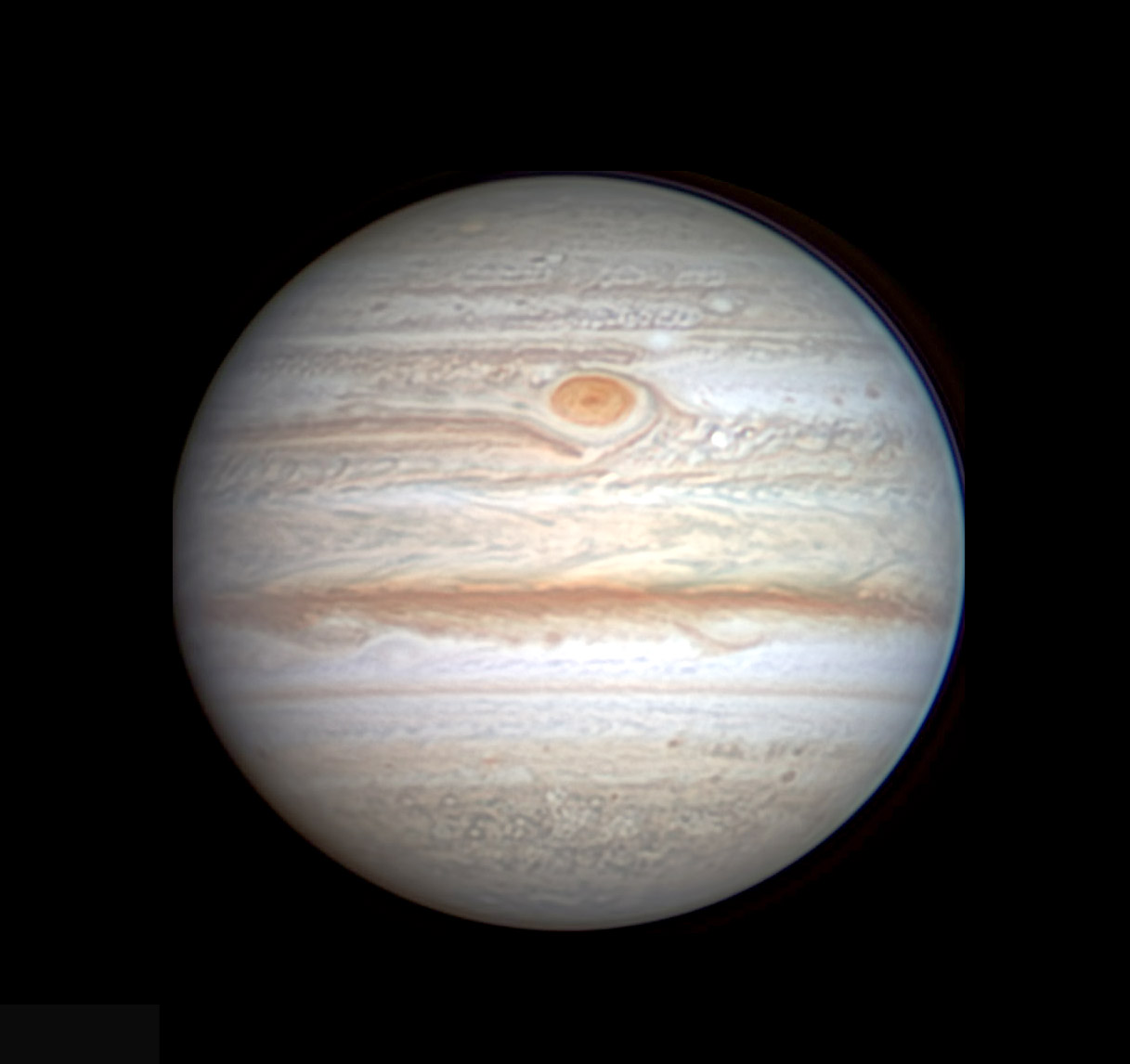
Saturn, magnitude +0.3 in western Capricornus, was at opposition on the night of August 13-14. Spot it low in the southeast in twilight, higher in the southeast in late evening, and at its highest and best in the south around midnight or 1 a.m. Saturn's rings appear roughly as wide, end to end, as Jupiter's globe. See "Saturn at Opposition" in the August Sky & Telescope, page 48.
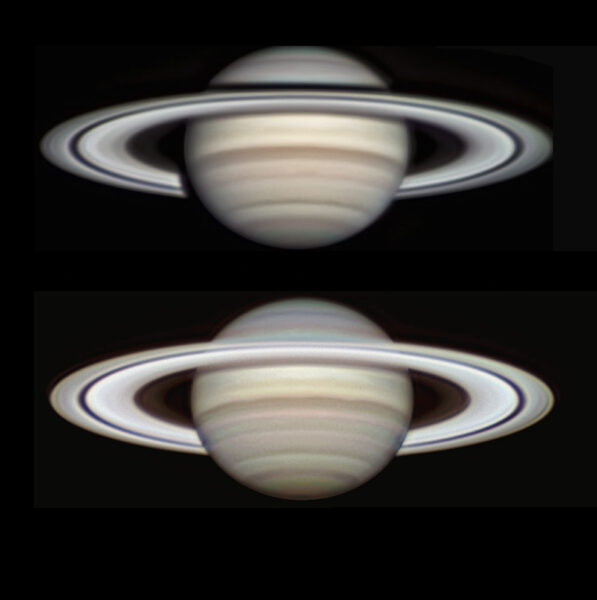
Christopher Go took both images. South here is up. We have adjusted the originals to make the globes appear similar, to show the actual amount of the rings' brightening realistically. It's not dramatic but definitely noticeable in the eyepiece if you're a regular Saturn observer.
Uranus, magnitude 5.7 in Aries, is west of Mars before dawn.
Neptune, magnitude 7.8 at the Aquarius-Pisces border, rises in evening twilight west of Jupiter. It's high in the south in the hours before dawn.
All descriptions that relate to your horizon — including the words up, down, right, and left — are written for the world's mid-northern latitudes. Descriptions and graphics that also depend on longitude (mainly Moon positions) are for North America.
Eastern Daylight Time, EDT, is Universal Time minus 4 hours. (Universal Time is also called UT, UTC, GMT or Z time.)
Want to become a better astronomer? Learn your way around the constellations. They're the key to locating everything fainter and deeper to hunt with binoculars or a telescope.
This is an outdoor nature hobby. For an easy-to-use constellation guide covering the whole evening sky, use the big monthly map in the center of each issue of Sky & Telescope, the essential magazine of astronomy.
Once you get a telescope, to put it to good use you'll need a detailed, large-scale sky atlas (set of charts). The basic standard is the Pocket Sky Atlas (in either the original or Jumbo Edition), which shows stars to magnitude 7.6.

Next up is the larger and deeper Sky Atlas 2000.0, plotting stars to magnitude 8.5; nearly three times as many. The next up, once you know your way around, are the even larger Interstellarum atlas (stars to magnitude 9.5) or Uranometria 2000.0 (stars to magnitude 9.75). And be sure to read How to Use a Star Chart with a Telescope. It applies just as much to charts on your phone or tablet as to charts on paper.
You'll also want a good deep-sky guidebook. A beloved old classic is the three-volume Burnham's Celestial Handbook. An impressive more modern one is the big Night Sky Observer's Guide set (2+ volumes) by Kepple and Sanner.
Can a computerized telescope replace charts? Not for beginners, I don't think, and not on mounts and tripods that are less than top-quality mechanically, meaning heavy and expensive. And as Terence Dickinson and Alan Dyer say in their Backyard Astronomer's Guide, "A full appreciation of the universe cannot come without developing the skills to find things in the sky and understanding how the sky works. This knowledge comes only by spending time under the stars with star maps in hand."
![]() Audio sky tour. Out under the evening sky with your
Audio sky tour. Out under the evening sky with your
earbuds in place, listen to Kelly Beatty's monthly
podcast tour of the heavens above. It's free.
"The dangers of not thinking clearly are much greater now than ever before. It's not that there's something new in our way of thinking, it's that credulous and confused thinking can be much more lethal in ways it was never before."
— Carl Sagan, 1996
"Facts are stubborn things."
— John Adams, 1770
 3
3









Comments
Rod
August 13, 2022 at 1:19 am
I did enjoy some observing last night and early this morning. [Observed 2130-0030 EDT 12-August through early morning 13-August. Sunset 2005 EDT, waning gibbous moonrise 2100 EDT in Aquarius. Full Moon was 12-August-2022 at 0136 UT. The show tonight was Saturn viewing along with some Perseid meteors and Jupiter. Saturn opposition 13-14 August. Perseid meteor peak 12-13 August. I did see 2 Perseid meteors this evening. 2245 EDT, one bright Perseid streaking SW away from the radiant and about 1st magnitude. Shortly after 0003 EDT on the 13-August, I observed a bright Perseid flash by nearly over head moving away from the radiant towards the SW. It was about as bright as Vega or magnitude 0. I used the 90-mm refractor telescope to view Saturn. Some excellent views using #12 Yellow filter with TeleVue 14-mm Delos and TeleVue 1.8x Barlow lens at 129x. Cassini division, Titan and Rhea moons visible, and cloud banding in northern area. At Jupiter I used #12 Yellow filter and #58 Green filter at 129x. Numerous cloud bands visible along with the 4 Galilean moons. In the north up, mirror reverse view of the refractor telescope, Io on the left side, Europa and Ganymede closer together on the right side, along with Callisto farther away from Jupiter's limb. The waning gibbous Moon in Aquarius was very bright after rising so made it difficult to view Perseid meteors. I did enjoy the small telescope views of Saturn and Jupiter. Near 2130 EDT when I came out, some great horn owls were hooting and making quite a bit of noise in the woods. The night hunters were all stirred up. Weather 17C with calm winds or light and variable, very clear skies.]
You must be logged in to post a comment.
Ernie Ostuno
August 13, 2022 at 1:52 am
We had clouds coming in here in West Michigan but there was an orange Perseid fireball (-4 estimated mag.) in clear skies just below Cassiopeia at 2300 EDT (0300 UTC). Another burst of three meteors at 2346 EDT with the brightest one around -2 est. mag. moving from Cassiopeia to Cygnus and visible through some thin cirrus and altocumulus clouds. Then a lull (which usually seems to follow bursts of multiple meteors) for about a half hour then a couple bright ones in different parts of the sky, one in Andromeda and two near Polaris and the Little Dipper. Pretty good show for being a full moon.
You must be logged in to post a comment.
Rod
August 13, 2022 at 10:23 am
Ernie, very nice Perseid observation report. I was in MD along the Patuxent River valley farms for my 13-Aug post.
You must be logged in to post a comment.
You must be logged in to post a comment.